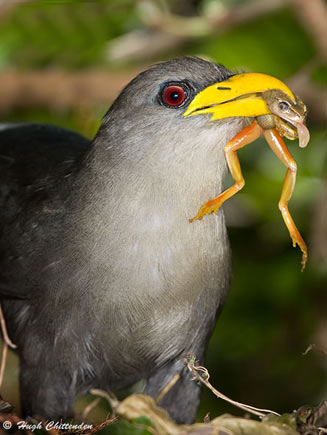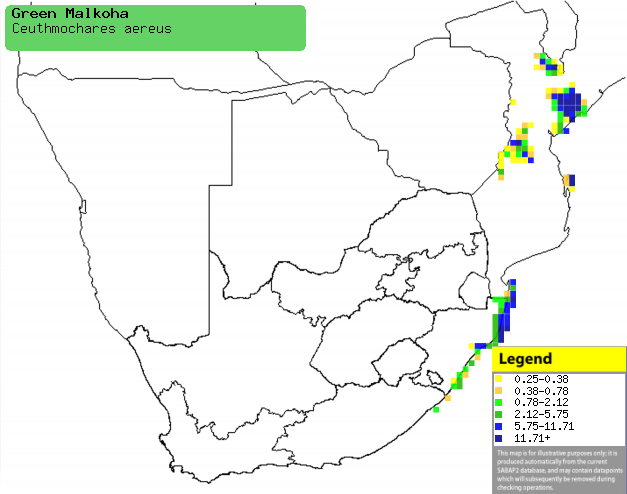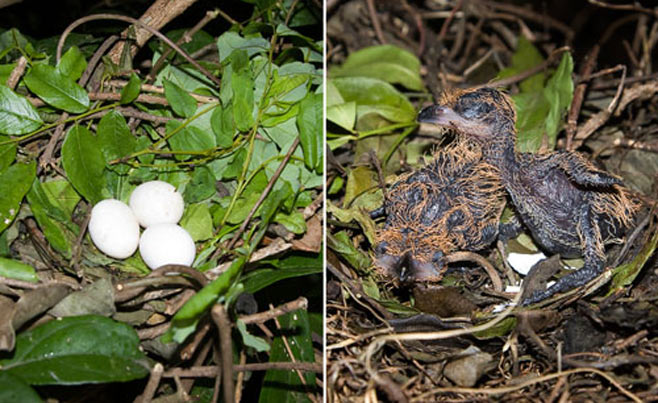|
Ceuthmochares aereus (Green
malkoha ,
Green coucal)
Groenvleiloerie [Afrikaans]; Geelsnavelmalkoha [Dutch];
Malcoha à bec jaune [French]; Erzkuckuck [German]; Cucal-verde
[Portuguese]
Life
> Eukaryotes >
Opisthokonta
> Metazoa (animals) >
Bilateria >
Deuterostomia > Chordata >
Craniata > Vertebrata (vertebrates) > Gnathostomata (jawed
vertebrates) > Teleostomi (teleost fish) > Osteichthyes (bony fish) > Class:
Sarcopterygii (lobe-finned
fish) > Stegocephalia (terrestrial
vertebrates) > Tetrapoda
(four-legged vertebrates) > Reptiliomorpha > Amniota >
Reptilia (reptiles) >
Romeriida > Diapsida > Archosauromorpha > Archosauria >
Dinosauria
(dinosaurs) > Saurischia > Theropoda (bipedal predatory dinosaurs) >
Coelurosauria > Maniraptora > Aves
(birds) >
Order: Cuculiformes > Family: Cuculidae
 |
 |
|
Green malkoha, Dlinza Forest, KwaZulu-Natal, South
Africa. [photo
Guy Upfold ©] |
Green malkoha with Hyperolius frog at nest,
Dlinza Forest, KwaZulu-Natal, South Africa. [photo
Hugh Chittenden ©] |
The Green malkoha occurs in band extending across eastern
sub-Saharan Africa, from Kenya to Mozambique and KwaZulu-Natal. It usually
prefers dense thickets at forest edges, avoiding the middle of the forest. It
mainly eats insects and small vertebrates, usually foraging in dense vegetation
but occasionally emerging to catch termite alates or caterpillars. It is
probably monogamous, nesting on a flimsy platform of twigs and plant detritus,
usually concealed in thick vegetation. There is little more information about
its breeding habits, as there have been no large studies done on this species.
Distribution and habitat
Occurs from Kenya trough Tanzania to Mozambique and eastern KwaZulu-Natal. It
generally prefers dense thickets at forest edges,
avoiding the middle of the forest.
|
 |
|
Distribution of Green malkoha in southern Africa,
based on statistical smoothing of the records from first SA Bird Atlas
Project (©
Animal Demography unit, University of
Cape Town; smoothing by Birgit Erni and Francesca Little). Colours range
from dark blue (most common) through to yellow (least common).
See here for the latest distribution
from the SABAP2. |
Food
It mainly eats insects and small
vertebrates, usually foraging in dense vegetation but occasionally emerging to
catch termite alates or caterpillars. The following food items have been
recorded in its diet:
- Animals
- invertebrates
- vertebrates
- Tree-frogs
- Small birds, caught in mist nets
- Fruit (rarely)
Breeding
- Unlike most cuckoos it is not a brood parasite, instead nesting
solitarily in monogamous pairs.
- The nest is a flimsy platform
of twigs and plant detritus, usually concealed in thick vegetation.
- It lays 2-4 eggs in the period from October-December.
 |
|
Green malkoha eggs (left) and chicks (right) in
the nest in Dlinza Forest. [photos
Hugh Chittenden
©] |
- The incubation of the eggs and caring of the chicks has not been
studied.
Threats
Not globally threatened.
References
-
Hockey PAR, Dean WRJ and Ryan PG (eds) 2005. Roberts
- Birds of southern Africa, VIIth ed. The Trustees of the John Voelcker
Bird Book Fund, Cape Town.
|
